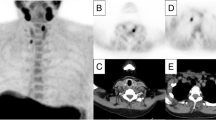Abstract
Background
Minimally invasive parathyroidectomy (MIP) has gained acceptance as the preferred surgical procedure for management of primary hyperparathyroidism (pHPT). Appropriate selection of patients for a MIP is a crucial step in its utilization. The aim of the study was to evaluate the role of 18F-FCH PET/CT as second-line imaging for accurately directing MIP.
Methods
This is a retrospective single-center study. Seventy-two patients with biochemical evidence of pHPT and a non-conclusive or negative first-line imaging (ultrasound and dual isotope subtraction scintigraphy) received 18F-FCH PET/CT between January 2018 and February 2020. All imaging studies were performed at our institution. Assessment of therapeutic changes and outcomes was performed.
Results
of the 72 patients imaged with 18F-FCH PET/CT, 54 subsequently underwent parathyroidectomy. When considering the ability of 18F-FCH PET/CT alone to predict a uniglandular disease, the sensitivity, specificity, PPV and NPV were 92.7% (95%CI: 80.1—98.5), 46.2% (19.2–74.9), PPV 87.3% (80.5—92) and NPV 61.2% (31.4—84.5), respectively. When we combined the data provided by 18F-FCH PET/CT with the data already collected from 1st line imaging we were able to complete a minimally invasive surgery in 38 of the 41 (92%) patients with a uniglandular disease. Thirteen patients (24%) had a multiglandular disease, all of them except one underwent bilateral neck exploration based on the data collected by all imaging modalities combined. Overall, cure was achieved in 53 (98%) patients.
Conclusion
18F-FCH PET/CT, interpreted along with first-line imaging results in selected patients, can better facilitate utilization of MIS while maintaining exceptional cure rates.


Similar content being viewed by others
References
Tunninen V, Varjo P, Schildt J et al (2013) Comparison of five parathyroid scintigraphic protocols. Int J Mol Imaging 2013:921260
Caveny SA, Klingensmith WC 3rd, Martin WE et al (2012) Parathyroid imaging: the importance of dual-radiopharmaceutical simultaneous acquisition with 99mTc-sestamibi and 123I. J Nucl Med Technol 40(2):104–110
Klingensmith WC 3rd, Koo PJ, Summerlin A et al (2013) Parathyroid imaging: the importance of pinhole collimation with both single- and dual-tracer acquisition. J Nucl Med Technol 41(2):99–104
Krakauer M, Wieslander B, Myschetzky PS et al (2016) A prospective comparative study of parathyroid dual-phase scintigraphy, dual-isotope subtraction scintigraphy, 4D-CT, and ultrasonography in primary hyperparathyroidism. Clin Nucl Med 41(2):93–100
Schalin-Jantti C, Ryhanen E, Heiskanen I et al (2013) Planar scintigraphy with 123I/99mTc-sestamibi, 99mTc-sestamibi SPECT/CT, 11C-methionine PET/CT, or selective venous sampling before reoperation of primary hyperparathyroidism? J Nucl Med 54(5):739–747
Hindie E, Melliere D, Jeanguillaume C, Urena P, deLabriolle-Vaylet C, Perlemuter L (2000) Unilateral surgery for primary hyperparathyroidism on the basis of technetium Tc 99m sestamibi and iodine 123 subtraction scanning. Arch Surg 135(12):1461–1468
Petranovic Ovcaricek P, Giovanella L, Carrio Gasset I et al (2021) The EANM practice guidelines for parathyroid imaging. Eur J Nucl Med Mol Imaging 48(9):2801–2822
Christakis I, Khan S, Sadler GP, Gleeson FV, Bradley KM, Mihai R (2019) (18)Fluorocholine PET/CT scanning with arterial phase-enhanced CT is useful for persistent/recurrent primary hyperparathyroidism: first UK case series results. Ann R Coll Surg Engl 101(7):501–507
Mathey C, Keyzer C, Blocklet D et al (2021) (18)F-fluorocholine PET/CT is more sensitive than (11)C-methionine PET/CT for the localization of hyperfunctioning parathyroid tissue in primary hyperparathyroidism. J Nucl Med 121:262395
Hindie E, Schwarz P, Avram MA, Imperiale A, Sebag F, Taieb D (2021) Primary hyperparathyroidism: defining the appropriate preoperative imaging algorithm. J Nucl Med 62(Suppl 2):3S-12S
Asseeva P, Paladino NC, Guerin C et al (2019) Value of (123)I/(99m)Tc-sestamibi parathyroid scintigraphy with subtraction SPECT/CT in primary hyperparathyroidism for directing minimally invasive parathyroidectomy. Am J Surg 217(1):108–113
Whitman J, Allen IE, Bergsland EK, Suh IA, Hope TA (2021) Assessment and comparison of fluorocholine PET and sestamibi scans in identifying parathyroid adenomas: a meta-analysis. J Nucl Med 62:1285
Hope TA, Graves CE, Calais J et al (2021) Accuracy of (18)F-fluorocholine PET for the detection of parathyroid adenomas: prospective single center study. J Nucl Med 62:1511
Graves CE, Hope TA, Kim J et al (2021) Superior sensitivity of (18)F-fluorocholine: PET localization in primary hyperparathyroidism. Surgery 171:41
Funding
The authors have no funding or financial support for this manuscript.
Author information
Authors and Affiliations
Corresponding author
Ethics declarations
Conflict of interest
The authors have nothing to disclose.
Ethical approval
The study was approved by the Assistance Publique-Hôpitaux de Marseille ethics advisory committee. Waiver of patient consent was granted by the ethics committee, given the retrospective nature of the study
Informed consent
Informed consent was obtained from all individual participants included in the study.
Additional information
Publisher's Note
Springer Nature remains neutral with regard to jurisdictional claims in published maps and institutional affiliations.
Rights and permissions
About this article
Cite this article
Goren, S., Paladino, N.C., Laks, S. et al. Diagnostic Rechallenge with 18F-FCH PET/CT Often Allows Minimally Invasive Parathyroidectomy While Maintaining Exceptional Cure Rates. World J Surg 46, 2409–2415 (2022). https://doi.org/10.1007/s00268-022-06629-3
Accepted:
Published:
Issue Date:
DOI: https://doi.org/10.1007/s00268-022-06629-3




